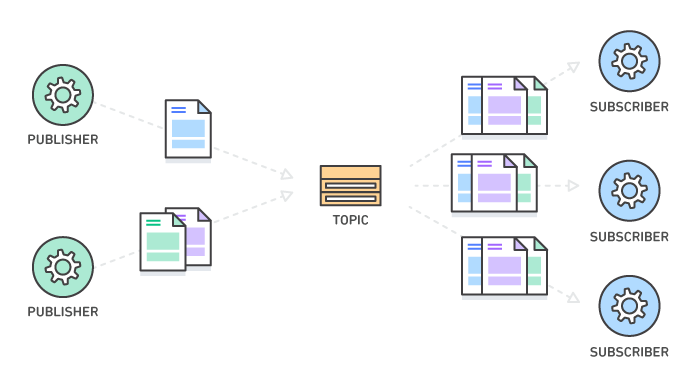Asynchronous messaging is that sender does not expect an immediate response and does not “blocks” waiting for the response. He will carry out his remaining tasks.
This article will introduce common patterns and compare 3 popular technologies for asynchronous messaging.
Asynchronous messaging patterns
There are two basic patterns in asynchronous messaging (and more variants):
- Message queue
 Using
Using queueas a message broker. One message can only be consume by a consumer. Unconsumed messages will be stored in queue until timeout.
- Publish/subscribe
 When a message is published, it is send to all subscribers who subscribed to the
When a message is published, it is send to all subscribers who subscribed to the topicof the message.
Java Messaging Service (JMS)
JMS has been one of most successful asynchronous messaging technology available. With the growth of the Java adoption of large enterprise applications, JMS has been the first choice for enterprise systems. It defines the API for building the messaging systems.
- A standard messaging API for Java platform.
- Supports two messaging models:
queueandtopic. - Supports transactions, message format, and long-lived store and forward.
- Not interoperable with other platforms or languages, and does not define a wire level protocol.
Advanced Message Queueing Protocol (AMQP)
There was no standard wire level protocol with JMS. And AMQP provided a standard wire level protocol and many other features to support the interoperability and rich messaging needs for the modern applications.
- A platform-independent wire level messaging protocol.
- Supports consumer-driven messaging, interoperability, buffer-oriented performance, and distributed transactions.
- 5 exchange types:
direct,fanout,topic,headers, andsystem. - Complex and not suitable for small devices or low bandwidth networks.
Message Queueing Telemetry Transport (MQTT)
Devices with less computing power cannot deal with all the complexities of AMQP rather they want a simplified but interoperable way to communicate.
This was the fundamental requirement for MQTT.
- A stream-oriented, low memory consumption messaging protocol.
- Supports publish-subscribe for topics, ephemeral messaging, and last value queue.
- Simple security and global namespace.
- Not support transactions, long-lived store and forward, fragmented messages, or connection security.
Reference
https://javaguide.cn/high-performance/message-queue/message-queue.html#jms-%E5%92%8C-amqp
https://chanakaudaya.medium.com/comparison-of-asynchronous-messaging-technologies-with-jms-amqp-and-mqtt-4f1bc21c26c5
https://blogs.mulesoft.com/migration/asynchronous-messaging-patterns
https://medium.com/@miladev95/message-broker-and-rpc-c0b1906738b1
https://www.cloudamqp.com/blog/what-is-message-queuing.html
https://aws.amazon.com/what-is/pub-sub-messaging